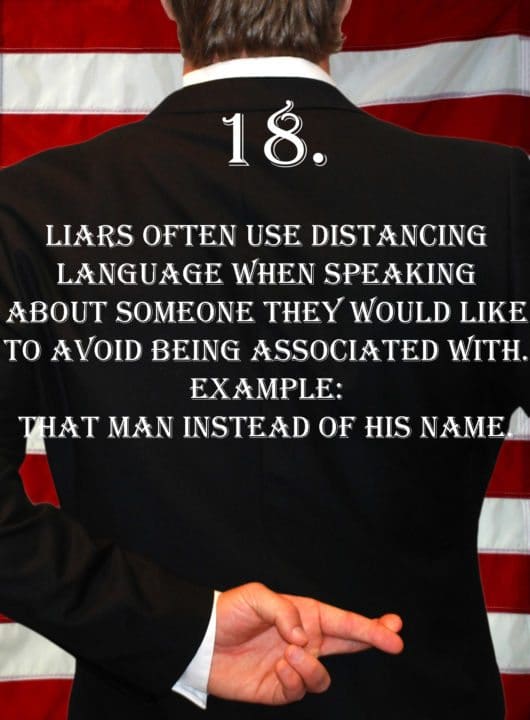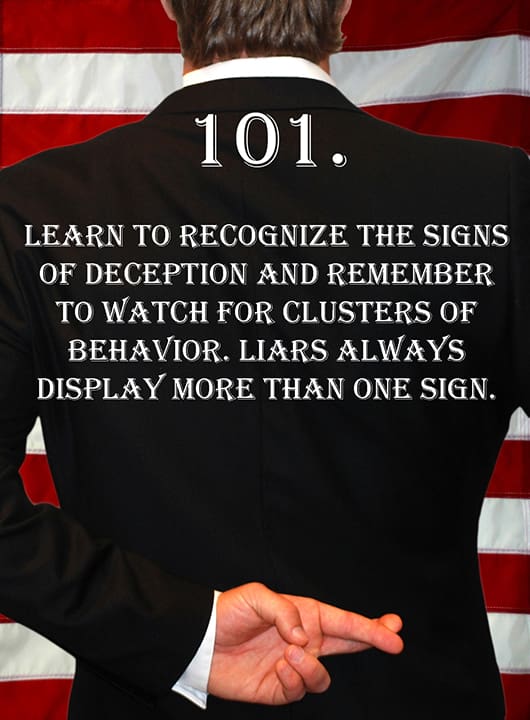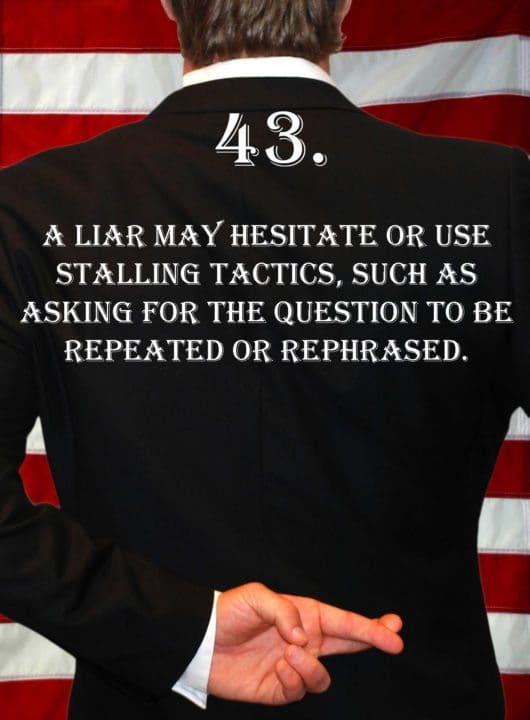
Deception Tip 18:
Liars often use distancing language when speaking about someone they would like to avoid being associated with.
Example: That man instead of his name.
Listen To The Podcast!
E18 – Distancing Language – Deception Tips Podcast – Click Here To Subscribe
Podcast Transcript
Hello, and welcome to the Deception Tips Podcast, where you will learn amazing cues to detect deceit that will help you read people like never before. I’m your host, Spencer Coffman. Let’s get started.
Welcome to another episode of the Deception Tips Podcast. This is episode 18. If you’re enjoying this podcast, I encourage you to leave a review. It really helps me out and it helps get other people to find and discover this great podcast. So, take the time to do that. It only takes a few minutes and I’d really appreciate it.
Last time, we talked about a cool thing that you can notice when people are telling their stories. We talked about how liars often use more details in their stories than truth-tellers.
One of the main reasons for this is because they are trying to convince, not only the target but also themselves of the lie. As a result, they’re using detail after detail to try to paint a more vivid picture.
And, the reason this is done is speculated because when we read fiction books, we see that imagination going. We see those vivid pictures painted for us so that we can really get into the story and put ourselves there.
We can see and feel exactly what’s happening and exactly what the author is trying to tell us. It only makes sense then that, when we’re telling a fictitious story, we naturally incorporate those details as well because that’s what we’re used to.
So, when people lie, they include a lot of details. And, that’s something for you to pay attention to and watch out for. Liars try to convince themselves and the target of their lie. That is a very important point.
Use other tactics that we’ve learned, such as accepting lies- like liars will accept a lie that you tell them. So, give them some details. Start to pretend you believe their story in order to get them to divulge more or to run with the details that you give them.
You could give them an entirely fictitious detail that you know is a lie and then they will start to run with that. And then you could say, “Well! I know they’re lying now because the thing I gave them was completely a lie and now they’re incorporating it into their story and going on and on about it.” Now you know they’re lying.
Today, we are going to talk about a different sign of deception that we’ve hinted at a couple of times before. And, it happens all the time when people get involved in scandals, or when there are accusations of dealing with people and they lie about whether or not they dealt with them, or did business with them, or are involved with them, etcetera.
Today, we are going to talk about something called “distancing language.” Now, distancing language is when people use certain words in a certain way to separate themselves from certain individuals. Examples of this would be “that man” or “that woman” — something along those lines.
So, here it is, Deception Tip 18: Liars often use distancing language when speaking about someone they would like to avoid being associated with. Example: “that man” instead of his name. Here it is again. Deception Tip 18: Liars often use distancing language when speaking about someone they would like to avoid being associated with. Example: “that man” instead of his name.
We see this all the time with sexual scandals, typically involving politicians. One I’m sure comes to mind for you because we’ve talked about it before. And, in his statement, there are so many lying behaviors that it was obvious he was lying. This was the Bill Clinton/Monica Lewinsky scandal when he says, “I did not have sexual relations with that woman.” *sound bite*
When we’ve talked about this before, I’ve pointed out many signs. You’ll notice his hand gestures if you watch the video clip on YouTube. You can see his pointing gesture. We talked about how gestures and speech need to be in unison.
They need to be congruent with one another. They should happen at the same time. They need to be symmetrical and simultaneous. This was in episode 12 when we talked about simultaneous gestures. When people use their body language to emphasize what they’re saying their arms, their fingers, or whatever needs to point and move at the same time they’re saying words.
If you watch the video clip again on YouTube about Bill Clinton when he said that, you’ll notice that his fingers were a little bit off with what he was saying.
In addition, when you listen to the audio, you will hear the “did not” where he separates that out. We talked about that a long time ago in episode number 5 when we talked about contractions and how liars often separate the contraction to create more emphasis on their statement. So, when he said “did not” that could be a lying gesture or a lying behavior.
In addition, the final one he used- and there could be more if you look at his face or other things/different body language- but the final one that we can talk about right now is when he said, “that woman.” He distanced himself from her by saying, “that woman.”
The normal scenario would have said, “No. I didn’t have sexual relations with Monica,” or, “with Miss Lewinsky,” or whatever. But he called her, “that woman.” And, this happens a lot when you see distancing language in politicians and also in the workplace or in business deals where people would say, “Oh. I would never associate with that man.” Or, “I would never think about going into business with that person.” Examples like that where people distance themselves from other people.
Now, when they do use those distancing terms sometimes it can be true. Such as, “I would never go into business with that person.” Well, that’s probably the truth because you haven’t gone into business with them yet, but you are distancing yourself from them.
So, when people use distancing language in a lie it is an attempt to mirror the truthful distancing language that people use. It’s an attempt to make people better believe those lies because distancing language is used, by definition, to distance people.
So, if I say, “I would never go into business with that person.” Well, that means that number 1: I really don’t like that person because I didn’t use their name, or I didn’t use their business name.
Obviously, I don’t like them. And by saying “that person” instead of their company, or their firm or whatever, that tells you that I don’t like them. But then I say that I would never go into business with them, which emphasizes again the fact that I don’t like them.
Why wouldn’t I go into business with them? Well, there could be a number of reasons. Maybe I do like them, but that would be why I don’t go into business with them because we’re friends.
But then, I would not say “that person.” I would usually say, “Well, I would never go into business with my friend.” Or, “I would never go into business with them because he’s my friend.” You wouldn’t distance yourself from them.
Distancing language is typically done when the circumstances are not favorable: when you don’t like that person, you don’t get along, etcetera. So, this is a huge deal because when distancing language is used in truth it is a separator.
It is distant from them. But when it is used in lying, it’s often to cover up the fact that they have done something together and they are trying to distance themselves. We’re going to talk a lot more about this, coming up next.
Do you ever wonder if that smile from the person you’re interested in is sincere? Or is it merely polite? Spencer knows. He’s published ground-breaking research on smile detection and his books can give you more insight into what that person is really feeling.
It is important to note that distancing language can be a natural part of speech and behavior when it is used in certain circumstances. However, when it is used it is really something that shouldn’t be used at all because it’s a distance. It puts a separation and walls between you, or whoever is speaking, and the people they are speaking about.
For example, when people often join a new job, or they start to start a new term on a board, or an elder’s group, or something like that, when they’ve joined a board of directors, oftentimes new members will use distancing language when talking about the group.
They’ll say, “you guys” or certain things that they’re really not a part of. That’s indicating that they’re still not used to being there. They use distancing language when they first join that board.
Now, as they start to identify more with that organization and that group, they start to make some friends, they start to feel like they’re part of the elders, or they start to feel that their opinion matters, then they start using more inclusive language. Such as things like, “we” or “our” or “us”- things like that. They start to call it “their” stuff. Whereas, when they’re not, they start using more distancing language until they feel comfortable.
This is important because that is natural for people to experience and for people to do. Until they feel like they’re a part of whatever group they’re in, they use distancing language because they’re still talking about a group that they don’t feel like they belong in.
So, they feel distant from them. This is very important. A good tip: when adding new members or when adding people to your group, use inclusive terms and encourage them to feel welcome and to feel like they’re a part of it so they don’t use that distancing language.
Now, it’s not a lie when they use it because they truly don’t feel like they’re a part of that. So, this is a very, very good indicator. When people use distancing language, in normal conversation or when they’re talking about something they’re involved in, pay attention to that because if they’re using that, then unconsciously they may not feel like they belong there. Or they may not feel like they are a valuable part of that group or a valued member.
So, if you are in that group, what can you do to make them feel like they belong or make them feel a little more valuable? They’re using distancing language for a reason and if it’s not because they’re lying, then it’s because they truly don’t feel like they belong.
So, make them feel welcome. Make them feel like they belong. Either that or kick them out because then they don’t belong or they don’t want to belong. Whatever the case may be. It’s either feels like they don’t belong or they don’t want to belong and they’re tired of being there. Either way, something needs to be done to change that distancing language so that it becomes more natural.
And, when people lie, as we said, they use distancing language to purposefully distance themselves from the situation. “I would never go to that place.” “I would never eat at that establishment.” Instead of, “I would never go to (whatever restaurant)” Or, “I would never eat at Burger King.” Or whatever examples you want to put in.
In addition, a lot of times people who are invested in certain situations and are talking with other people- maybe they’re talking with someone who isn’t involved in that situation.
So, for example, let’s say you are a board on an ABC corporation. You’re a board member and you’re talking with someone else who’s maybe working with that corporation, or who works there, and they’re not a board member.
But yet, there’s a conversation about some kind of board function, or a little party, a meet-and-greet, or something and you say, “Well, maybe we should have a beer at that place.” And they say, “Oh! We totally should!” They’re really not included in your board, but you’re talking about ‘we,’ as in you’re going to bring them and help them feel included. That’s normal.
Whereas, oftentimes, it could be something like, “We should have a beer at that party.” “Well, I’m not a part of that board, so I shouldn’t.” That’s a distance.
Pay attention to that because if they use things like inclusive terms such as ‘our,’ ‘we,’ and ‘together,’ ‘us,’ then you know that they can be a part of it. They feel like they’re a part of it. They feel like they belong. Now, this is unconscious.
In addition, that’s more truthful. It’s more honest. It’s more a sense of unison. It’s belongingness. Whereas, on the other hand, if they use terms like ‘his,’ ‘her,’ ‘that,’ and other distancing language then you know that they don’t feel like they’re a part of it.
Or, it could be something where they could be lying and they may not feel like they belong or they’re just not telling the truth and they don’t want to belong. They’re separating themselves from that.
A common example would be something like, if someone is a board member and they’re talking to another board member or a group, and they say, “When is your annual meeting?” Well, you’re a part of the board. It should be “When is our annual meeting?”
So, you know something’s not right. They don’t feel like they belong there. So, a little tip for you is when you join a group or an organization, or you start to get involved with other people, or you have a team or anything like that, start using more inclusive language.
If you hear people using some distancing language within that group, counter it with ‘we’ or ‘our’ or ‘us’ or things like that. Or, if someone says that they want to be distant, or they’re using that distancing language implying.
Saying like, “Why don’t you do this?” Or how about, “You guys do that,” and you’re still a part of it, you could counter that with your own distancing language, such as, “Yeah, you should.” And then they’ll kind of realize, “Well, yeah. I shouldn’t be putting everything on everybody else.” Instead, it should be ‘us’ and ‘we.’
So, use those and follow up all the time. If people start to be distant and they’re not fully committed- because their language will reflect their commitment to that group. So, if you see that, correct people. Say, “Yeah. You should do this.” Or, if they say “you should,” say, “Uh, we should.” Because they need to know that they’re a part of that group and they belong to that group and that they are an important part of that group.
And when people are lying pay very, very close attention to the distancing language because it’s happening for some reason. And, usually, when it’s lying, it will be along the lines of “that woman,” and “that person,” and you’ll also hear it in the tone of their voice.
They’re going to say things, usually with the term ‘that.’ Or, “I would never do anything with that person.” It’s not going to be, “I would never do anything with her,” because ‘her’ is more of a- it’s closer. They’re going to use a farther out term such as “that person”, or “that business,” or “that establishment,” etcetera.
So, keep that in mind. The point is always to pay attention to distancing language. If you see it, or if you hear it happen, then look for other behaviors as well because, if there aren’t any other behaviors present, it’s more of a possibility that they are truly feeling distant from whatever they’re talking about, and maybe something needs to change. If there are other behaviors present, then you know they’re lying and something can be done about that as well.
I want to thank you for listening to this week’s episode of the Deception Tips Podcast. I encourage you to share it with your friends, subscribe to the feed, follow the Deception Tips Blog, and take a look at the books I have available. And, as always, tune in next week for a new Deception Tip.
Video Transcript
Hey guys, my name is Spencer Coffman. Thank you for tuning in to the Deception Tips videos, they’re all about teaching you how to read people and detect deception so that you will be able to tell if someone is lying to you.
Today, we are going to talk about some cool examples of deception and body language. That is something where it happens quite often, and you may or may not have seen it before, and in addition, when you do see it, when it does happen, you don’t really know that it’s deception, because it sounds like a natural part of speech. It’s when people start to separate themselves from certain situations and certain people. It’s called distancing language.
When people start to use this type of language, they’re distancing themselves from whatever is taking place or whatever is about to take place, or whomever else is involved in the situation. It tells you that they really don’t want to be involved, they have no identification with those people, or they want to convey that they have no identification with those people.
So here it is, this is deception tip number 18. “Liars often use distancing language when speaking about someone they would like to avoid being associated with. Example: That man instead of his name.
So now this could happen with anything. It could be “that man,” “that person,” “that woman,” “that kid,” etc. But it’s instead of their name. Typically, when talking about other people, you would use their name. Or you would say my friend, or my whatever, business partner, or my spouse, my wife, my husband, Etc., my kid. You would use kind of more of an identification type of noun or pronoun to identify that person. Whereas if you use a distancing language, such as that man, or that woman, or that kid, that is separating yourself from that person.
Usually, we use names, we say, “yeah, yesterday my friend John and I, we went down to the beach and it was absolutely packed.” Instead, if you use something like, “yeah, that person and I were at the beach.” Now you kind of know that there’s a little bit of an attitude about that, like, “that person and I? Wow, like, what did he do to make me mad?” Type of a thing.
In addition, when people are in business negotiations or are asked to buy stuff, or do things with certain places, now this could be in consumer, like you could go to Walmart or Target or whatever, and some people might say, “oh, I would never shop at that place, or I would never eat at that restaurant,” things like that. That is distancing themselves from that particular establishment or that business.
In addition, this can happen in the financial world where people will say, “oh, we would never do business with that organization, or we would never give them our business.” Something like that. They’re using those “that’s, them’s” separation, and they’re distancing themselves from the situation. They’re not identifying with that.
Now this is typically, also can be seen like, if you were to join a new board or a new group, or something like that, until you start to feel like you identify with that group, you’re going to call it like, “oh, that organization, or that meeting, or that board.” But then eventually, as you start to identify it, you’ll start to use more identification language, like “our board, or our group, or our meeting.” Or, “Yeah, come over to our church,” or something like that, instead of “yeah, that church, or the church over here.” Those are separations. So this is important in two ways.
Number one is when people lie, they tend to separate themselves from the person or the situation in which they are placed. So, for example, “were you at such-and-such location yesterday?” “Oh, I would never go there.” Or, “I would never go to that place.” They’re separating themselves from that. They kind of further enhance their alibi. Or, “were you with so and so last night?” “Oh, I would never be seen with that person,” type of a thing.
Then the other side of this is when people are joining groups, or when there’s teamwork happening, or employees or something like that, if they’re using distancing language, then you know that they don’t feel like they belong in a part of that group. So, therefore, either they don’t want to belong and they maybe need to get the boot, or they are not sure how they fit in, and then something needs to be done to kind of make them feel like they belong there. Either way, it’s when people are separating themselves, it’s a red flag.
Now, there’s a very, very famous political thing that happened with this, and it was with distancing language. I’ve talked about it in the podcast, so you can check that out, or if you already know what it is, you can check it out online, but I’m not going to say what it is here, because you can check that out on your own.
If this is your first time watching these videos, I would love to have you subscribe to the YouTube channel. In addition, leave any comments you may have with questions or anything like that. Also, if you’d like some more information, we’ve got books, podcasts, and blog posts all available on SpencerCoffman.com that are completely dedicated to teaching you what every body is really saying.
Until next time.






